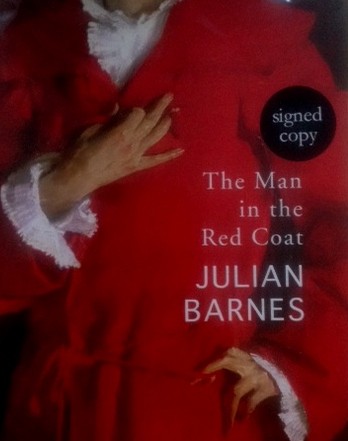Inspiring Older Readers
 posted on 27 Oct 2020
posted on 27 Oct 2020
The Man in the Red Coat by Julian Barnes
In 1885 a trio of friends arrived in England from France for “an intellectual and decorative” shopping trip. They were the society doctor and acclaimed gynaecologist Samuel-Jean Pozzi and his friends, the Prince de Polignac and Count de Montesquiou-Fezensac.
Both Polignac and Montesquiou were avowedly gay, the doctor emphatically heterosexual and something of a philanderer. Montesquiou is also rich, a wildly snobbish and disdainful aesthete, the model for Des Esseintes in Huysmans’ novel of decadence and perversity, Against Nature (reviewed HERE). The prince is ripping through his inheritance and in fact nowhere near as wealthy as he seems. In a few years time he will embark on a successful ‘white marriage’ with a fabulously rich lesbian heiress from America, thus in one stroke ensuring their respectability while at the same time refilling his aristocratic coffers many times over.
Just a few years previously, the doctor – dashingly handsome, slender, opulently robed – had been the subject of a portrait called ‘Dr Pozzi at Home’, by John Singer Sargent. He is ‘the man in the red coat’ of the book’s title, his hands and long, expressive fingers somehow erotically charged, the tasseled cord of his robe (actually a dressing gown) hanging down (according to Barnes) “like a bull’s pizzle”. The portrait is at once cavalierly intimate – domestic, and yet wealth, cultivated taste and social prestige are all overtly implied – and obscurely sexual. Viewed by Barnes in 2015 it was this portrait that inspired his book, both an elegy for Belle Époque France and – as he says in an afterword – a howl of rage against “Britain’s deluded, masochistic departure from the European Union”.
Perhaps only Julian Barnes would conceive of writing a profoundly researched history of the mores and manners of Belle Époque France and its social, cultural and artistic elite as a protest against Brexit. Odd as this may sound, I think it says something about Barnes the man – it may also say something about why I found this book such hard-going.
Let me first say that the book was an unexpected gift. The fact that I had intended to buy a copy but had neglected to do so, coupled with the fact that in hardback it is a beautifully produced volume, with generous creamy pages, superbly reproduced plates, a finely stitched binding and a great jacket, made it all the more appreciated. I was all set to enjoy it. I had better try and explain why I didn’t.
On the positive side, it is a brilliant idea. To use three related but to most people somewhat obscure figures to exemplify Belle Époque values while also spinning an ever-expanding web of associations and ideas designed to immerse the reader in late-nineteenth century France is an undertaking of undeniable chutzpah. And Barnes captures the febrile atmosphere of imperial grandeur, immense wealth, aristocratic froideur, decadence and utter disdain for bourgeois convention superbly well. It is an immense labour of research and it is evident throughout that Barnes has relished the task. But while we sometimes say of the very best and most deeply researched books that they wear their erudition lightly, The Man in the Red Coat seems to wear its erudition smugly. My God, Barnes does seem pleased with himself. In the half of the book I managed to read I felt sure I could hear him murmuring in the background, “Just look how much I know about this stuff.”
I don’t know what would have made the book work, what would have made it come alive, and I’m sure the loss is mine, but once I had become acquainted with its methods – essentially: why leave anything out? – the more I read the less involving it became. I felt like a bystander before a carefully erected edifice of erudition – an edifice erected not for the pleasure of the reader but for the personal gratification of the writer. At times it felt like reading whatever the equivalent of Debrett’s might be for late-nineteenth century France.
Other readers – thankfully – will feel differently about it. Anyone with an interest in nineteenth century French history, culture, society and literature will almost certainly find something to applaud. I can only admit that it was the tone of the book – the tone of Barnes’s voice above all else – that put me off. And not for the first time. I have heard this same tone in some of his other non-fiction, as well as in some of his novels. Mind you, I think one of the best things he has ever written, The Noise of Time, his wonderful novel about Shostakovich, manages to expunge it entirely and consequently is an imaginative triumph, illuminating Shostakovich the man – compromises, guilt, paranoia, moral failings and all – as well as his time and place.
I just wish I could have been similarly impressed by The Man in the Red Coat. But I wasn’t. I was merely overwhelmed and eventually surplus to requirements. Julian Barnes was clearly managing perfectly well without me so I left him to it.
Alun Severn
October 2020